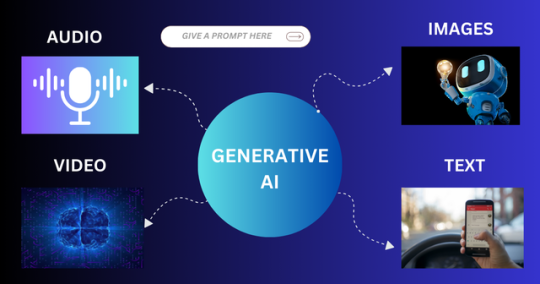Don't wanna be here? Send us removal request.
Text
GENERATIVE AI
Imagine a world where machines serve as creators. In this scenario, computers generate stunning images, compose music, craft engaging narratives, and establish legal frameworks. This exemplifies the transformative impact of Generative AI, a form of artificial intelligence that is reshaping technological capabilities.
Generative AI encompasses systems capable of producing new and original content, including images, music, coherent text, and functional software code. This contrasts sharply with traditional AI, which primarily focuses on analysis, categorization, and prediction. Advances in machine learning have paved the way for new types of neural networks, which continuously adapt to enhance performance and explore new application areas. This blog aims to elucidate the workings of generative AI, along with its advantages, disadvantages, and potential future contributions to the digital landscape.

How Generative AI Works Generative AI is founded on deep learning, a subset of machine learning that mimics human brain functions in processing information. Deep learning models are trained on extensive datasets, enabling them to detect patterns, comprehend relationships, and generate outputs that closely mirror human-generated content.
Key Components Neural Networks Generative AI utilizes advanced computational systems known as neural networks, including Generative Adversarial Networks (GANs) and transformer models. GANs consist of two components: a generator that produces new data and a discriminator that assesses the realism of the generated data, leading to mutual enhancement over time. Models such as OpenAI's GPT leverage attention mechanisms to process sequential data effectively, making them adept at generating text, images, and audio.
Training Data Generative models acquire knowledge from diverse sources such as text, images, videos, music, and various other data types. The quality and variety of this data significantly influence the output.
Latent Space Representation During the training phase, the AI learns to represent data within a lower-dimensional space known as latent space. This allows the model to produce multiple variations of the original data by navigating this space, resulting in new content that may rival or even surpass human creativity.
Applications of Generative AI Generative AI is revolutionizing various fields, altering work patterns and fostering innovation.
Text Creation Chatbots and virtual assistants, such as OpenAI’s ChatGPT and Google Bard, facilitate seamless interactions by answering questions and assisting with tasks through generative AI. This technology automatically generates content ranging from blog posts and marketing materials to social media captions while ensuring quality and contextual relevance. Additionally, screenwriters and novelists utilize AI for brainstorming plot ideas and co-authoring narratives.
Image and Video Production Tools such as DALL·E 3 and MidJourney enable the creation of extraordinary images by simply inputting text prompts. Artists employ these tools for idea generation and as initial drafts in their creative processes. Advanced generative AI and 3D editing also enhance video content and, in some instances, assist in the development of virtual environments.
Music and Sound Production Generative models like OpenAI’s MuseNet and Google’s Magenta can create new music across various styles, providing boundless creative opportunities for musicians and directors. AI-generated soundscapes are increasingly utilized in video games and film sound design.
Code Development Tools such as GitHub Copilot and Tabnine improve the coding experience by identifying errors and generating initial scripts for developers. Generative AI also optimizes automated software testing by producing test cases, enhancing quality assurance processes.
Gaming and Virtual Worlds AI-generated characters, narratives, and environments significantly enrich gaming experiences. Platforms like NVIDIA Omniverse employ AI to rapidly create immersive virtual worlds.
Advantages of Generative AI Generative AI offers numerous benefits across various sectors.
Increased Creativity and Productivity Generative AI fosters creativity by enabling professionals to express ideas, design, and automate routine tasks. Marketers can efficiently develop advertising campaigns, while musicians can explore innovative sounds.
Personalized Recommendations It provides tailored suggestions based on individual preferences, offering customized recommendations for products or designs. For instance, a clothing brand might showcase unique apparel designs, while an online retail platform can deliver personalized shopping experiences.
Accelerated Innovation Generative AI reduces the time and costs related to idea generation and product development. Startups and researchers can more easily brainstorm new concepts and focus on enhancing their innovations.
Challenges and Limitations Despite its considerable potential, generative AI presents several challenges.
Ethical Concerns Misinformation can disseminate false narratives and mislead individuals about AI-generated content, such as deepfakes.
Resource-Intensive Generative models demand substantial computational resources and extensive datasets for training and operation, often rendering them prohibitively expensive for smaller organizations.
Necessity for Human Oversight While capable of producing impressive results, generative AI often lacks contextual understanding, leading to inaccuracies or subpar outcomes. Human oversight is essential to ensure quality and accuracy.
The Future of Creative Design with AI Generative AI is rapidly evolving, with significant advancements expected soon.
Multimodal AI Future models will effectively integrate text, images, audio, and video, enhancing versatility. For example, a single prompt could enable an AI to generate an entire short film by producing the script, characters, visuals, and music. To Lean More...
0 notes
Text
AI IN DIGITAL MARKETING
Artificial Intelligence (AI) is no longer a futuristic concept—it’s transforming industries today, and digital marketing is no exception. From understanding customer needs to optimizing campaigns, AI is reshaping how businesses reach and engage their audiences. Let’s explore the innovative ways AI is influencing the future of digital marketing.

Dynamic Customer Segmentation One of the most significant advancements AI offers is the ability to segment customers in real time. Unlike traditional marketing, which segments based on demographics, AI analyzes behavioral data to group customers based on their actions. This allows marketers to create highly targeted campaigns that speak directly to customers' needs and interests. For instance, AI can identify trends such as frequent purchases or browsing patterns, helping brands target the right audience with relevant offers.
Voice Search Optimization As AI-powered voice assistants like Siri, Alexa, and Google Assistant become more popular, voice search is gaining traction. Marketers are now focusing on optimizing their content for voice queries. Voice search often differs from text searches, as users tend to ask full questions instead of using keywords. AI helps marketers understand these patterns and adjust their SEO strategies accordingly, ensuring that their content is discoverable through voice search.
Visual Recognition for Enhanced Shopping AI’s visual recognition capabilities are changing the way consumers shop. With AI-powered image search tools, customers can now upload photos of products they like, and AI will find similar items online. This feature is particularly beneficial for fashion and home decor brands, enabling users to discover new products without needing to know specific keywords. Pinterest, for example, has implemented this feature to allow users to find visually similar pins, enhancing the shopping experience.
Hyper-Personalized Advertising AI allows brands to go beyond standard personalization and deliver hyper-targeted ads. By analyzing a user’s past behavior, preferences, and even emotional state, AI can create ads that are highly relevant to individual users. This level of personalization significantly increases the chances of conversion because the ads feel more like personalized suggestions rather than generic promotions. Major platforms like Facebook and Google are already using AI to improve ad targeting and generate better results for businesses.
Sentiment Analysis for Better Engagement Understanding how customers feel about your brand is crucial for creating effective marketing strategies. AI-driven sentiment analysis tools scan social media posts, reviews, and comments to gauge public opinion about your brand in real time. This allows businesses to respond promptly to negative feedback or amplify positive sentiments. By leveraging sentiment analysis, brands can build stronger relationships with their audience.
Predictive Lead Scoring
First, AI assists marketers with predictive lead scoring: AI algorithms then kick in to evaluate leads, determine which types of prospects are more likely to convert by analyzing historical data and behavior patterns, instead of doing this manually. This enables to the marketing saves up on time and utilizes it in converting only those leads, because of which there are higher chances that such leads convert as customers. The likes of HubSpot and Salesforce are using AI to automate lead generation.
Make Informed Decisions using Real-Time Data
It gives marketers access to live data, and they make quick decisions from it. Be it analyzing the efficiency of an existing campaign or studying customer movements on a site, AI can get the work done with unprecedented speed. Therefore, businesses are no longer bound to old reports — using real-time information they can change marketing tactics as well.
AI-Driven Video Marketing
AI has turned video into a highly engaging content for marketers too. An AI can analyze video to break down every piece, and see exactly what keeps viewers watching: great for brands that want to keep them on the hook in something running ten minutes or more. Moreover, AI-enabled video editing solutions can automatically transcribe your content for captions and subtitle while providing you with short fragments to share on social media; which can save a lot of time & effort for creators.
Conclusion
AI is expanding the possibilities in digital marketing. Businesses are provided with the ability to improve customer experiences and boost results, from hyper-targeted advertising to real-time analytics. As such, so long as the AI tech continues to get modernized and updated for better future applications in digital marketing it will always be a useful tool for a business that wants keep a competitive edge in today's evolving digital landscape. learn more...
1 note
·
View note